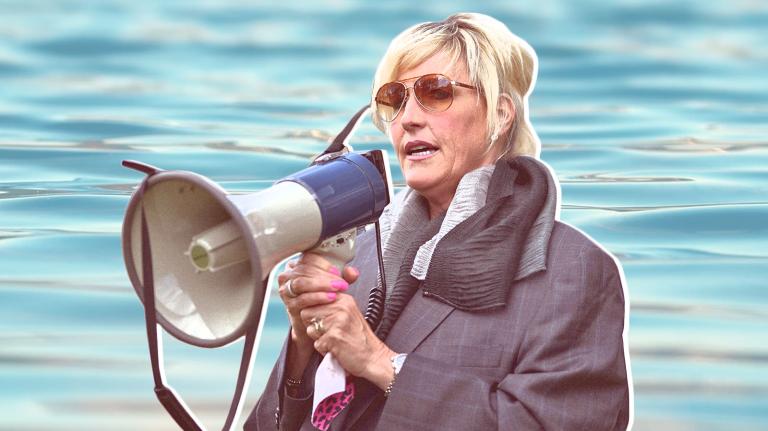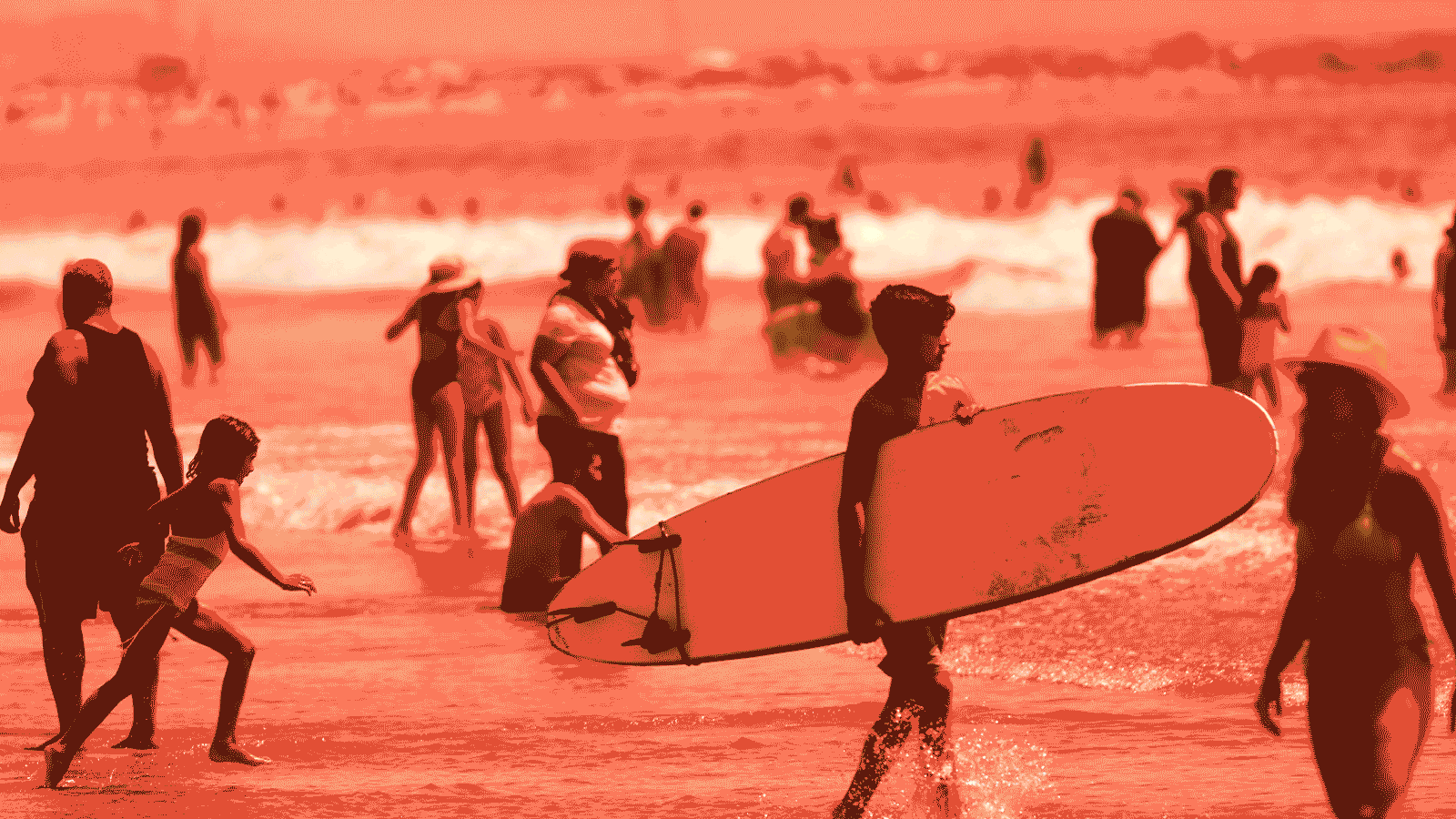Who isn’t mourning the waning weeks of summer? It’s the season most people look forward to all year. Long days on the beach, 9 p.m. sunsets, perfect tomatoes: What more could you want?
Well, maybe less of the destructive hurricanes, raging wildfires, and killer heat waves. The thermometer topped 110 Fahrenheit in Phoenix for a record-shattering 50th time this year on Friday. More 90-degree days are supposedly coming for the West and parts of the sweltering South. The forecast for Lake Charles, Louisiana, the town ravaged by Hurricane Laura last week, is a mix of humidity, heavy rain, and “excessive heat.”
All seasons come with their perils (snowstorms, allergy attacks, pumpkin spice lattes), but we tend to look at warmer months through rose-colored glasses. Arran Stibbe, a professor of ecological linguistics at the University of Gloucestershire in the United Kingdom, couldn’t stop thinking about how wrong the love of summer seemed in 2018, when Europe was roasting through a particularly miserable heat wave. “I was just really suffering from it every day,” he said. “It just felt so oppressive.”
But Stibbe didn’t see his suffering reflected in the news. So, being a linguist, he watched the weather forecast and kept track of the expressions he heard. What he found was a stark dichotomy: Forecasters described hot, sunny weather as glorious, fantastic, and unspoiled. They lamented the risk of a shower, the threat of mist, and disappointing rains. When heavy showers finally brought an end to the heat wave that killed hundreds in the U.K., it was called nasty weather.
“This is a story that is embedded deeply in our minds, that sunny weather is good and every other kind of weather is bad,” Stibbe said. That cultural belief is what causes people to flock to the beach in hot weather, never mind the sunburns and traffic jams. It’s also what prompts incredulous looks when you announce you’re going for a walk in the rain.
The fact is, heat kills more people each year than any extreme weather, but its risks are downplayed when sweltering, sunny days are painted as “glorious” and illustrated by photos of lazy beachgoers and people playing in fountains. The emphasis on the merits of high temperatures could also have implications for climate change: After all, if warmer weather is good, what’s there to worry about?
A lot, it turns out. Earlier this month, the western United States baked in a heat wave that fanned wildfires that have destroyed more than 1.25 million acres across California. Death Valley hit 130 degrees F, possibly the hottest temperature ever recorded on Earth. In recent years, it’s gotten so scorching in Phoenix that airplanes couldn’t take off from the airport, and so toasty in Winnipeg, Canada, that a hospital had to shut down its operating rooms because the ventilation system couldn’t handle the heat.
Hot temperatures are a “massively underreported” health threat, said Kristie Ebi, a professor of global health at the University of Washington. (Ebi was a lead author on two recent big-deal climate reports, the 2018 Intergovernmental Panel on Climate Change report and the 4th National Climate Assessment.) A recent study published in the journal Environmental Epidemiology looked at death records in two-thirds of U.S. counties from 1997 to 2006 and found that about 5,600 deaths each year were related to heat. That’s far more than the Center for Disease Control’s estimate of 702 heat-related deaths each year for the entire country from 2004 to 2018.
While federal agencies have spent a lot of time and money trying to figure out how to define a heat wave, Ebi said, much less has been invested in how to convince people to protect themselves from its dangers. The problem isn’t necessarily that people don’t know what to do (turn on fans and spray yourself with water). It’s that they just don’t do it. “We’re all guilty of it,” Ebi said. “We don’t think we’re at risk so we don’t necessarily follow the guidelines.”
Meteorologists are usually cautious when talking about the threat of heat because they’re not trained to give health advice, Ebi said. She suggested that forecasters could bring a guest from the state health department to talk about the risks of sweltering temperatures.
Even moderate heat can be a problem for the vulnerable, like older adults, young children, and people with chronic health problems or disabilities. “We’re giving a one-size-fits-all forecast,” Ebi said. “[But] it’s not one threshold for everybody.” She suggested the idea of giving “tiered forecasts” that would warn people that hotter-than-normal summer days could be dangerous for certain groups or in certain places. In a temperate city like Seattle, temperatures in the high 80s are worth warning about, she said. Even within the same city, one neighborhood can be much hotter than another: Extreme heat tends to be worse in redlined neighborhoods, where city planners often built highways instead of parks lined with trees.
Unsurprisingly, global warming is making it all worse. In 2018, Japan sizzled in a record-breaking heat wave that killed more than a thousand people. Scientists have since concluded that the event would have been impossible without climate change. The same year, Sweden experienced an exceptionally warm May that researchers said would happen only three times in 1 million years, were it not for climate change. The way statistical estimates are getting shattered, Ebi jokes that it might be more useful to just say such an event would never have happened without climate change.
If you believe that hot, sunny weather is good, then “global warming” might not sound like such an emergency. That’s why Stibbe is cautious about celebrating bouts of unseasonably warm weather. “If we’re having extreme hot weather in February that’s totally out of character, we need to stop saying how amazing and fantastic it is, and actually start to be a bit worried about climate change,” he said.
That’s not to say you should hole up indoors every time the sun comes out. Sunlight can have real mood-boosting effects. But it’s not the only kind of weather that people are capable of appreciating. In some ways, it’s a cultural preference. Stibbe points to Japanese haiku for examples of how to paint other kinds of weather more positively.
“Japanese haiku about weather is always appreciating the coolness on a summer evening, or appreciating the coolness of the breeze, rather than just loving the heat pounding down,” Stibbe said. A poem by the 18th-century Japanese poet Miura Chora calls spring rain “joyful at night” and “tranquil” during the day, a different message from what you normally hear in the English-speaking world.
Our emotions are tied to the weather, Stibbe said. Maybe if we learned to appreciate misty mornings and cool evenings, we’d learn to appreciate their emotional equivalents too, like nostalgia and melancholy, instead of waiting for the sun to show up and brighten our mood. If we gave it a try, he said, “we might just have better lives.”




